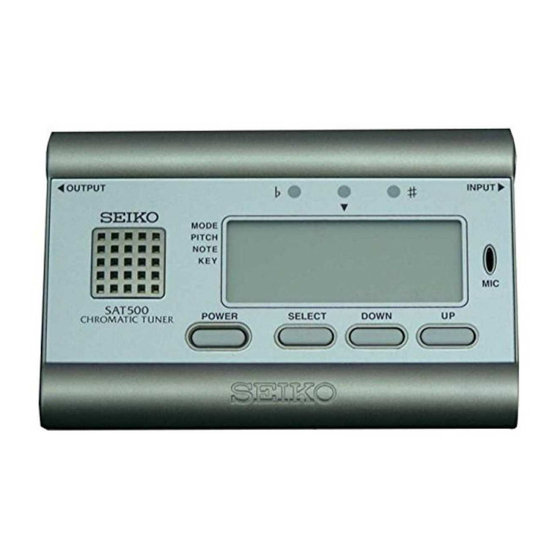Table of Contents
Advertisement
CHROMATIC TUNER SAT500
INSTRUCTION MANUAL
PARTS OF YOUR TUNER AND THEIR OPERATION
Before use, install the batteries included with the tuner, following the instructions in
Note: The batteries included with the tuner are monitor batteries, and the battery life may be shorter than
the specified period.
Power button
With each press, the tuner is turned on and off alternately.
Auto power-off function
If no button operation is made or no sound is input into the tuner for approximately
20 minutes while the tuner is turned on, it will be turned off automatically to save the
battery energy.
Selector button
Use the button to select the item of tuner setting. With each press, the setting item is
selected in order.
Printed mark
Setting item
Mode setting
Reference pitch setting
Note setting
Key setting
* For details, see "TUNER SETTING".
UP button
DOWN button
Use the buttons to change the settings of the item selected by pressing the selector
button
. The two buttons change the setting of the selected item in the opposite
order. For details, see "TUNER SETTING".
Liquid crystal display
Setting item indication
The pointer "
" indicates the item currently selected.
Tuning meter
It shows the difference in pitch between the note indicated on the display and that
given by the instrument.
Tuning mode indication
The tuning mode currently selected is shown.
Cent/reference pitch indication
The difference in pitch between the note indicated on the display and the one given
by the instrument is shown numerically. While the pitch setting is made, the
current reference pitch is shown.
Note indication
AUTO mode: The tuner automatically identifies and indicates the note given by
the instrument.
MANUAL and SOUND modes: The note you have set is indicated.
Key indication
The current key setting is shown.
Tuning guide
As a guide in tuning, it visually shows the difference in pitch between the note indicated
on the display and the one given by the instrument by means of the LED lights.
• When the pitch of the input note is lower than that of the indicated note, the " " LED
lights up.
• When the pitch of the input note is higher than that of the indicated note, the "
LED lights up.
• When the instrument is in tune, the LED at the center lights up in green.
Description
To set the tuning mode.
To set the frequency of the reference
pitch (A4).
To set the note you wish to tune.
To transpose the key.
"
Advertisement
Table of Contents

Summary of Contents for Seiko SAT500
- Page 1 CHROMATIC TUNER SAT500 INSTRUCTION MANUAL PARTS OF YOUR TUNER AND THEIR OPERATION Before use, install the batteries included with the tuner, following the instructions in “BATTERY CHANGE”. Note: The batteries included with the tuner are monitor batteries, and the battery life may be shorter than the specified period.
-
Page 2: Tuner Setting
Input jack When tuning an electric/electronic instument, connect the output cord of the instrument to the input jack . While the cord is connected to the input jack , the built-in microphone will not work. Output jack Bypass function The tuner outputs the signal input from the instrument connected with the input jack to an amplifier and other devices through the output jack Precautions on using the bypass function 1. -
Page 3: Auto/Manual Mode
Also, bring the instrument close to the tuner to register a note. If it is difficult to tune the instrument with the built-in microphone, it is recommended that a microphone, such as SEIKO STM-20, sold separately from the tuner, be used together with the tuner. - Page 4 SPECIFICATIONS MODE : AUTO mode/ MANUAL mode/ SOUND mode DISPLAY : Liquid crystal display and tuning guide TUNING RANGE : AUTO/ MANUAL mode A0 ~ C8 : ±1 cent ACCURACY REFERENCE NOTE : C4 ~ B4 (at one-semitone steps, when the key is set at “C”) REFERENCE PITCH RANGE : 415 Hz and 435 Hz ~ 446 Hz (at 1 Hz steps) ADDITIONAL FUNCTIONS : Auto power off, memory backup, transposition tuning, and bypass...





Need help?
Do you have a question about the SAT500 and is the answer not in the manual?
Questions and answers